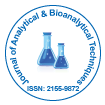Brief Note on Ultra-High-Performance Liquid Chromatography (UHPLC)
Received: 10-Jan-2024 / Manuscript No. jabt-24-126503 / Editor assigned: 12-Jan-2024 / PreQC No. jabt-24-126503 (PQ) / Reviewed: 23-Jan-2024 / QC No. jabt-24-126503 / Revised: 30-Jan-2024 / Manuscript No. jabt-24-126503 (R) / Accepted Date: 30-Jan-2024 / Published Date: 31-Jan-2024 QI No. / jabt-24-126503
Abstract
Ultra-High-Performance Liquid Chromatography (UHPLC) represents a significant advancement in chromatographic techniques, offering enhanced speed, sensitivity, and resolution. This brief note provides an overview of UHPLC, highlighting its principles, applications, and key advantages. UHPLC builds upon the foundation of traditional High- Performance Liquid Chromatography (HPLC) with a focus on minimizing particle sizes in the stationary phase and operating at elevated pressures. The use of smaller particles, often below 2 micrometers, coupled with higher pressures, results in improved efficiency and faster separations compared to conventional HPLC. The principles of UHPLC remain rooted in the fundamentals of chromatography, involving a liquid mobile phase and a finely packed column with a highpressure delivery system. The reduced particle size enhances surface area interactions, leading to sharper and more defined chromatographic peaks.
Keywords
Particle size; Pressure; Column technologies; Sensitivity
Introduction
Ultra-High-Performance Liquid Chromatography (UHPLC) represents a significant advancement in liquid chromatography technology, offering enhanced speed, efficiency, and resolution compared to traditional High-Performance Liquid Chromatography (HPLC) [11]. This modern chromatographic technique has become instrumental in various scientific disciplines, providing researchers with a powerful tool for rapid and high-resolution separation and analysis of complex mixtures [2]. UHPLC’s evolution builds upon the principles of HPLC, utilizing smaller particle sizes and higher pressures to achieve improved performance, making it an indispensable analytical tool in fields such as pharmaceuticals, environmental science, and biochemistry.
Discussion
Ultra-High-Performance Liquid Chromatography (UHPLC) [3] represents a significant advancement in liquid chromatography, designed to achieve higher efficiency, faster separations, and improved resolution compared to conventional High-Performance Liquid Chromatography (HPLC) [4]. This brief discussion explores the key features, principles, and applications of UHPLC.
Key features of UHPLC:
Smaller particle sizes: UHPLC employs stationary phase particles that are significantly smaller than those used in traditional HPLC columns. This reduction in particle size enhances column efficiency and leads to better resolution [5].
Higher pressures: UHPLC systems operate at much higher pressures compared to HPLC. This increased pressure allows for faster flow rates and shorter analysis times without compromising separation efficiency.
Reduced column lengths: The combination of smaller particle sizes and higher pressures enables the use of shorter columns in UHPLC, resulting in quicker elution times and improved chromatographic performance [6].
Enhanced sensitivity: UHPLC offers higher sensitivity and improved peak shapes, making it particularly advantageous for the analysis of complex samples and trace-level components.
Principles of UHPLC:
UHPLC follows the basic principles of liquid chromatography but incorporates technological improvements to achieve ultra-high performance [7]. The key principles include:
Stationary phase: Similar to HPLC, UHPLC employs a wide range of stationary phases, including reversed-phase, normal-phase, and specialty phases. The choice depends on the specific separation requirements.
Mobile phase: UHPLC typically uses the same liquid mobile phases as HPLC, with variations based on the nature of the analytes. Common mobile phases include water, acetonitrile, and methanol.
Column design: UHPLC columns are designed to withstand higher pressures and are packed with smaller particles, often below 2 micrometers in size, to maximize surface area and improve separation efficiency.
Applications of UHPLC:
Pharmaceutical analysis: UHPLC is extensively used in pharmaceutical industries for the rapid analysis of drug compounds, impurities, and degradation products, facilitating faster drug development and quality control processes [8].
Proteomics and biomolecule analysis: UHPLC is employed in the separation and analysis of complex biomolecules, such as proteins, peptides, and nucleic acids, supporting advancements in proteomics and genomics research.
Environmental monitoring: UHPLC is applied in environmental analysis for the rapid and efficient detection of pollutants, pesticides, and contaminants in air, water, and soil samples [9].
Clinical diagnostics: UHPLC is utilized in clinical laboratories for the rapid and precise analysis of biomarkers, drugs, and metabolites in biological fluids. Advantages of UHPLC:
Higher resolution: The smaller particle sizes and increased pressure in UHPLC result in improved peak resolution, making it particularly effective for complex sample analysis.
Shorter analysis times: UHPLC offers faster elution times, leading to shorter overall analysis times. This increased speed enhances laboratory throughput and efficiency [10].
Improved sensitivity: The enhanced chromatographic performance of UHPLC contributes to improved sensitivity, enabling the detection of low-abundance compounds in trace-level concentrations.
Conclusion
Ultra-High-Performance Liquid Chromatography represents a transformative advancement in liquid chromatography technology, offering superior resolution, faster separations, and increased sensitivity. Its wide-ranging applications in pharmaceuticals, biomolecule analysis, environmental monitoring, and clinical diagnostics highlight its pivotal role in advancing research and analytical capabilities across various scientific disciplines.
Acknowledgement
None
References
- Hodgkin K (1985) . Churchill Livingstone.
- Last RJ (2001) . Oxford: International Epidemiological Association.
- Kroenke K (1997) . J Gen Intern Med 12: 509–510.
- Kroenke K (2001) . Ann Intern Med 134: 844–853.
- Komaroff AL (1990) . Arch Intern Med 150: 1586–1587.
- Sackett DL, Haynes BR, Tugwell P, Guyatt GH (1991) . London: Lippincott, Williams and Wilkins.
- Mullan F (1984) . Public Health Rep 99: 442–445.
- Mullan F, Nutting PA (1986) . Fam Med 18: 221–225.
- Abramson JH (1984) . Public Health Rep 99: 437–441.
- Hart JT (1974) . J R Coll Physicians Lond 8: 299–314.
, ,
, Crossref ,
,
,
,
,
Citation: Ashley N (2024) Brief Note on Ultra-High-Performance LiquidChromatography (UHPLC). J Anal Bioanal Tech 15: 600.
Copyright: © 2024 Ashley N. This is an open-access article distributed under theterms of the Creative Commons Attribution License, which permits unrestricteduse, distribution, and reproduction in any medium, provided the original author andsource are credited.
Share This Article
天美传媒 Access Journals
Article Usage
- Total views: 316
- [From(publication date): 0-2024 - Jan 10, 2025]
- Breakdown by view type
- HTML page views: 270
- PDF downloads: 46
